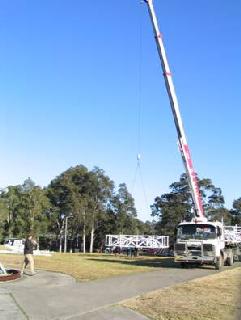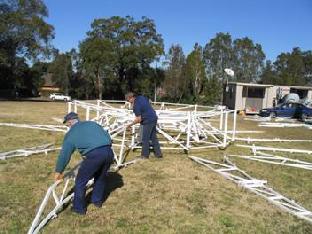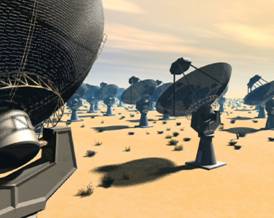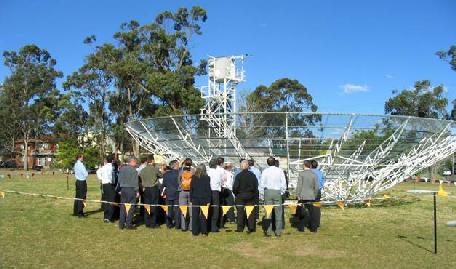SKA and xNTD news
Australian SKA planning news
New Technology Demonstrator dishes arrive at CSIRO Radiophysics Laboratory
The Major National Research Facilities program, the New Technology Demonstrator (NTD) project is to design and develop a technology demonstrator for the SKA. This CSIRO project will lead to the construction and operation of two parabolic dishes equipped with focal-plane arrays.
Refurbished antennas from the old Fleurs radio telescope run by the University of Sydney are being installed on the CSIRO Radiophysics site at Marsfield in NSW by the engineering company, Sydney Engineering. Final adjustments are being made for a new surface mesh, and new drive and control systems are being installed and tested.
A prototype 24-channel beam-former has been built and a prototype version of software has been written for polyphase filtering. In this first stage of the demonstrator, focal-plane arrays are being sourced from overseas suppliers. A key milestone is the completion of the antenna test-platform using the dishes, a Thea tile from ASTRON in The Netherlands, and the prototype beam-former ready to conduct initial experiments. The target date is October 2005.


Left: Delivery of the hub of an NTD dish at CSIRO Radiophysics Laboratory at Marsfield, August 2005. Photo: Tony Sweetnam. Right: Early meccano training comes into good use in reconstruction of the NTD antenna! Ken Skinner and Craig Best of Sydney Engineering starting to put together the dish structure. Photo: Tony Sweetnam
Australian SKA Planning Office (ASPO)
As the SKA project gathers momentum in Australia the Australian SKA Planning Office (ASPO) has been formed within CSIRO ATNF to implement the policy of the Australasian SKA Consortium and to manage the coordination of SKA activities in Australia. Professor Brian Boyle has been appointed the Australian SKA Director.
Information on ASPO activities can be found in the ASPO newsletters at www.atnf.csiro.au/news/press/ASPOnewsletter1.pdf and www.atnf.csiro.au/news/press/ASPOnewsletter2.pdf .
Further information on the SKA project can be found on the international SKA website at www.skatelescope.org . If you would like to become a member of the Australian SKA email group to receive information about SKA activities and events, please contact Dr Michelle Storey, ASPO Leader.
Michelle Storey
(Michelle.Storey@csiro.au)
Cost-effective antenna designs for the xNTD
 Figure 1: Simulation based on 15-m antennas, each equipped with a focal-plane array. Image credit: CVA Film & Television/Chris Fluke, Centre for Astrophysics and Supercomputing, Swinburne University of Technology.
Figure 1: Simulation based on 15-m antennas, each equipped with a focal-plane array. Image credit: CVA Film & Television/Chris Fluke, Centre for Astrophysics and Supercomputing, Swinburne University of Technology. CSIRO's extended New Technology Demonstrator (xNTD) project, led by the ATNF, will build a new radio telescope based on an array of 20 antennas. Each antenna will be equipped with a focal-plane array (FPA) and the xNTD will be based at Mileura in Western Australia.
The antennas (dish, drive and mount) are a critical element in the xNTD project, yet at the present time there is no design that meets all of the requirements in terms of cost and specification. The xNTD antennas will be between 12 and 20 m in diameter and will operate across the 500 MHz to 2.5 GHz frequency range. The target cost of one entire xNTD antenna (dish, mount and drive) is AUD 250 K. The "xNTD antenna challenge" for the xNTD project is driven to the extreme by the SKA project: The target cost for a 15-m antenna corresponds to a cost of AUD 1,415 per square meter of collecting area; for comparison the target within the SKA budget is AUD 735 per square meter assuming it is based on 15-m antennas.
As both the xNTD and SKA projects require minimalist antennas there are significant efforts around the world in the SKA community in this area. Novel solutions are being investigated by the South African Karoo project (which has a similar overall specification to the xNTD) as well as SKA R&D underway in India.
 Figure 2: Participants at the "Antenna design for the xNTD" workshop admire one of the two 13.8-m diameter Fleurs telescope dishes, currently being refurbished on the Marsfield range. These antennas will form the NTD. Photo: Diana Londish
Figure 2: Participants at the "Antenna design for the xNTD" workshop admire one of the two 13.8-m diameter Fleurs telescope dishes, currently being refurbished on the Marsfield range. These antennas will form the NTD. Photo: Diana Londish
Possible cost reduction options already identified by the xNTD team include approximating a true paraboloid in the reflector shape, allowing some gravitational deformation, and using a lightweight 6-mm ´ 6-mm mesh as the surface material to reduce wind loading and weight bearing requirements.
To explore the interest within industry in developing the xNTD antenna, we held a half-day workshop at Marsfield on 15 September 2005. Twenty representatives from Boeing Australia Ltd, Connell Wagner, Australian Institute for Commercialisation, Sinclair Knight Mertz, Ball Solutions, BAE Systems Australia, Tenix Pty Ltd, Raytheon Australia Pty Ltd and Radio Frequency Systems attended and the initial feedback has been very positive.
The xNTD project has invited industry to prepare brief proposals of interest to conduct a design study for the xNTD antenna. These proposals are due by 25 November 2005. When these have been reviewed we anticipate that more detailed design concepts will be developed under paid contracts, to be completed in mid-March 2006. Depending on the outcome of these proposals the xNTD team will consider progressing one (or more) to the prototyping stage.
Follow-up information from the workshop, including the presentations made on the day can be found at www.atnf.csiro.au/projects/ska/industry_2/ pw-antennas.html.
Carole Jackson (ATNF Business Development Manager and ASPO Industry Liaison), Colin Jacka (xNTD Project Leader) and Mike Kesteven (xNTD Antenna Development Leader)
(Carole.Jackson@csiro.au)
